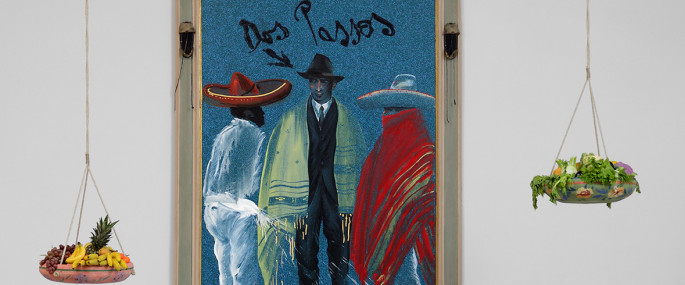

Bio
Aldo Mondino
Born in 1938 in Turin, where he died in 2005.
In 1959 he moved to Paris, where he trained for two years at William Heyter’s Atelier 17. He studied mosaic with Gino Severini. In those years, he came into contact with young surrealist painters such as Jouffroy, Errò, Lebel, and well established masters like Matta and Lam – an experience that left its traces in his playful works of the 1960s.
In 1961 he returned to to Turin for military service in Italy. His meeting with Gian Enzo Sperone, director of Galleria Il Punto, proved to be decisive. And indeed it was in his gallery that he presented his first solo show (1963).
The paintings where direct citations of the artists Casorati, Capogrossi and Dine – with references to the world of pop, road signage and world of children. In 1964 he shows in a solo show at Galleria La Salita. In 1969 he presented Ittiodromo at Arco d’Alibert in Rome. From that moment he started to experiment with unusual materials such as sugar (Sugar rose, 1972). In 1970 he started his King series.
In 1976 he took part in the 38th Venice Biennale, where he devoted himself to creating a philological parallel between his art and Schoenberg’s composition. In 1983, he put on an exhibition on the subject of angels at Studio De Ambrogi in Milan. Curator Marco Menguzzo invited him in 1988 to take part in “Verso l’Arte Povera” event at the Padiglione d’Arte Contemporanea in Milan.
In 1985 he started his cycle devoted to to travel: Spain, Morocco, Turkey, India and the Orient in general. In his paintings with oriental-style subjects, Mondino focuses on characters from Arab life, but also rabbis, orthodox Christians, Turkish sultans and whirling dervishes, without neglecting everyday characters such as merchants at the bazaars.
In 1989 he shows in a solo exhibition at Arte Fiera in Bologna with Galleria Astuni, and at Mediterranea and Galleria Artiscope in Brussels. In his later years, however, he expressed himself also in sculpture, which was one of his greatest aspirations. He made a bronze cast entitled Boccioni’s mother in which the woman’s breast consists of two large balls. His insatiable curiosity later led him to investigate do-it-yourself and ceramics, which he also interpreted as an element for the decoration of paintings.
At Galleria Sperone in Rome, he put on an exhibition with works made of chocolate and sugar (1990). In 1993, he exhibited a series of large-format paintings of the whirling dervishes at the Venice Biennale. For the occasion, Mondino invited a company of dervishes for a dance performance, creating an unforgettable and highly poetic moment in which the works on show were flanked by real dancers.
During those years the Orient, with its faces and colours, became the dominant element in his poetic expression (Shekitah, 1994, and La siesta, 1997). In 1996 gallerist Alessandro Bagnai organised an exhibition in Siena, where he showed works representing the Corrida and the Palio. In 1997 Galleria Astuni organised a big exhibition titled “From King Solomon to the Gnawa”, with more than fifty works.
Mondino’s love for the three dimensional led him to experiment with unusual materials, such as chocolate. The works in the shows “The Byzantine World” in Milan (Galleria 1000eventi) and in Rome (Galleria Sperone), 1999, were entirely made of little chocolates.
In 2000 he made his first trip to India and he shows in an exhibition called Flowers at the Birla Academy in Calcutta.
In 2001 Galleria Astuni organised a double solo exhibition: “Gnawa” and “Torso torsolo rosicchiato da Rodin” curated by Luca Beatrice.
Aldo Mondino was never afraid of going against the flow, and indeed he did so intentionally. His creative vein, which was backed up by his vast culture, led him to experiment all the time, reinventing the currents that had inspired him, mocking those artists from whom he distinguished himself, and provoking in order to feel himself free.
Mondino died for an heart attack on 10 March 2005 in Turin, where he had been born 67 years earlier.







